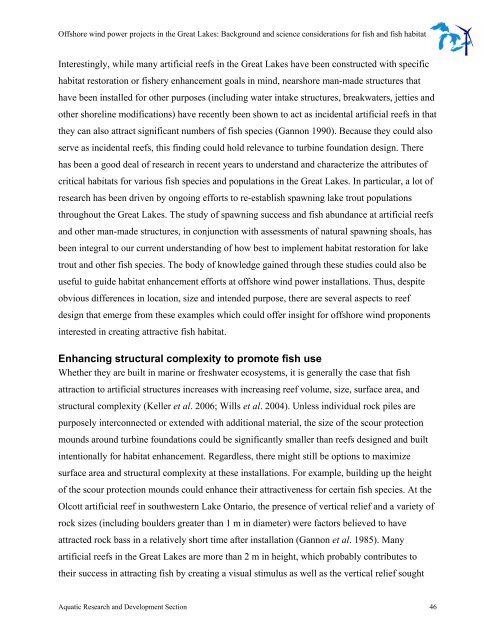Offshore Wind Power Projects in the Great Lakes - Ministry of ...
Offshore Wind Power Projects in the Great Lakes - Ministry of ...
Offshore Wind Power Projects in the Great Lakes - Ministry of ...
You also want an ePaper? Increase the reach of your titles
YUMPU automatically turns print PDFs into web optimized ePapers that Google loves.
<strong>Offshore</strong> w<strong>in</strong>d power projects <strong>in</strong> <strong>the</strong> <strong>Great</strong> <strong>Lakes</strong>: Background and science considerations for fish and fish habitat<br />
Interest<strong>in</strong>gly, while many artificial reefs <strong>in</strong> <strong>the</strong> <strong>Great</strong> <strong>Lakes</strong> have been constructed with specific<br />
habitat restoration or fishery enhancement goals <strong>in</strong> m<strong>in</strong>d, nearshore man-made structures that<br />
have been <strong>in</strong>stalled for o<strong>the</strong>r purposes (<strong>in</strong>clud<strong>in</strong>g water <strong>in</strong>take structures, breakwaters, jetties and<br />
o<strong>the</strong>r shorel<strong>in</strong>e modifications) have recently been shown to act as <strong>in</strong>cidental artificial reefs <strong>in</strong> that<br />
<strong>the</strong>y can also attract significant numbers <strong>of</strong> fish species (Gannon 1990). Because <strong>the</strong>y could also<br />
serve as <strong>in</strong>cidental reefs, this f<strong>in</strong>d<strong>in</strong>g could hold relevance to turb<strong>in</strong>e foundation design. There<br />
has been a good deal <strong>of</strong> research <strong>in</strong> recent years to understand and characterize <strong>the</strong> attributes <strong>of</strong><br />
critical habitats for various fish species and populations <strong>in</strong> <strong>the</strong> <strong>Great</strong> <strong>Lakes</strong>. In particular, a lot <strong>of</strong><br />
research has been driven by ongo<strong>in</strong>g efforts to re-establish spawn<strong>in</strong>g lake trout populations<br />
throughout <strong>the</strong> <strong>Great</strong> <strong>Lakes</strong>. The study <strong>of</strong> spawn<strong>in</strong>g success and fish abundance at artificial reefs<br />
and o<strong>the</strong>r man-made structures, <strong>in</strong> conjunction with assessments <strong>of</strong> natural spawn<strong>in</strong>g shoals, has<br />
been <strong>in</strong>tegral to our current understand<strong>in</strong>g <strong>of</strong> how best to implement habitat restoration for lake<br />
trout and o<strong>the</strong>r fish species. The body <strong>of</strong> knowledge ga<strong>in</strong>ed through <strong>the</strong>se studies could also be<br />
useful to guide habitat enhancement efforts at <strong>of</strong>fshore w<strong>in</strong>d power <strong>in</strong>stallations. Thus, despite<br />
obvious differences <strong>in</strong> location, size and <strong>in</strong>tended purpose, <strong>the</strong>re are several aspects to reef<br />
design that emerge from <strong>the</strong>se examples which could <strong>of</strong>fer <strong>in</strong>sight for <strong>of</strong>fshore w<strong>in</strong>d proponents<br />
<strong>in</strong>terested <strong>in</strong> creat<strong>in</strong>g attractive fish habitat.<br />
Enhanc<strong>in</strong>g structural complexity to promote fish use<br />
Whe<strong>the</strong>r <strong>the</strong>y are built <strong>in</strong> mar<strong>in</strong>e or freshwater ecosystems, it is generally <strong>the</strong> case that fish<br />
attraction to artificial structures <strong>in</strong>creases with <strong>in</strong>creas<strong>in</strong>g reef volume, size, surface area, and<br />
structural complexity (Keller et al. 2006; Wills et al. 2004). Unless <strong>in</strong>dividual rock piles are<br />
purposely <strong>in</strong>terconnected or extended with additional material, <strong>the</strong> size <strong>of</strong> <strong>the</strong> scour protection<br />
mounds around turb<strong>in</strong>e foundations could be significantly smaller than reefs designed and built<br />
<strong>in</strong>tentionally for habitat enhancement. Regardless, <strong>the</strong>re might still be options to maximize<br />
surface area and structural complexity at <strong>the</strong>se <strong>in</strong>stallations. For example, build<strong>in</strong>g up <strong>the</strong> height<br />
<strong>of</strong> <strong>the</strong> scour protection mounds could enhance <strong>the</strong>ir attractiveness for certa<strong>in</strong> fish species. At <strong>the</strong><br />
Olcott artificial reef <strong>in</strong> southwestern Lake Ontario, <strong>the</strong> presence <strong>of</strong> vertical relief and a variety <strong>of</strong><br />
rock sizes (<strong>in</strong>clud<strong>in</strong>g boulders greater than 1 m <strong>in</strong> diameter) were factors believed to have<br />
attracted rock bass <strong>in</strong> a relatively short time after <strong>in</strong>stallation (Gannon et al. 1985). Many<br />
artificial reefs <strong>in</strong> <strong>the</strong> <strong>Great</strong> <strong>Lakes</strong> are more than 2 m <strong>in</strong> height, which probably contributes to<br />
<strong>the</strong>ir success <strong>in</strong> attract<strong>in</strong>g fish by creat<strong>in</strong>g a visual stimulus as well as <strong>the</strong> vertical relief sought<br />
Aquatic Research and Development Section 46
















